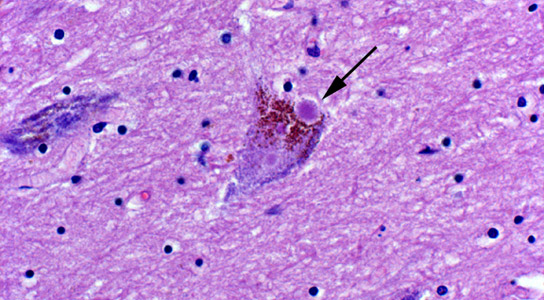Link Between Cell Death & Protein Clumps Could Lead to Possible Treatment for Parkinson’s
November 16, 2012

Lewy body on a protein, image via University of California at San Francisco
The researchers published their findings in the journal Science. Virginia Lee, a neurobiologist at the University of Pennsylvania in Philadelphia, and her team a misfolded synthetic version of the protein α-synuclein into the brains of normal mice and saw the key characteristics of Parkinson’s disease develop and progressively worsen. The study suggests that the disease is spread from one nerve cell to another by the malformed protein, rather than arising spontaneously in cells.
This suggests that an antibody that binds the misfolded α-synuclein could be used to intercept the protein as it passes between nerve cells. “It’s very hard to ask antibodies not only to get inside the brain, but to get inside cells,” says Lee. “But now you have the possibility of stopping the spreading. And if you stop the spreading, perhaps you can slow the progression of the disease.”
Back in 2008, when transplants of fetal nerve tissue given to patients with Parkinson’s developed the characteristic clumps associated with the condition, it was hypothesized that the disease might be spread from neuron to neuron. The nearby diseased cells had somehow infected the transplanted tissue. Subsequent studies have shown that misfolded α-synuclein can spread to neighboring cells and cause cell death.
It still remained an open question whether this transfer played a significant role in the disease, states Tim Greenamyre, director of the Pittsburgh Institute for Neurodegenerative Diseases in Pennsylvania.
There are two distinct features in Parkinson’s: clumps of protein called Lewy bodies and a traumatic loss of nerve cells that produce the chemical messenger dopamine. When Lee’s team injected the misfolded α-synuclein into a part of the mouse brain rich in dopamine-producing cells, Lewy bodies began to form. This was followed by the death of dopamine neurons. Nerve cells that linked to those near the injection sites also developed Lewy bodies, a sign that cell-to-cell transmission was taking place.
The study lends theoretical support to the biotechnology companies that are sponsoring clinical trials of α-synuclein antibodies for Parksinson’s, states Eliezer Masliah, a neuroscientist at the University of California, San Diego. It should also spur research on how the protein gets in and out of cells.
There is still no clear explanation as to why Lewy bodies appear in the first place.
No comments:
Post a Comment